
A Comprehensive Basketball Skills Improvement Plan
Basketball, a game of skill, strategy, and athleticism, demands continuous improvement to reach peak performance. Whether you’re a seasoned player aiming for a higher level of play or a beginner taking your first steps on the court, a structured skills improvement plan is crucial for progress. This comprehensive guide outlines a detailed plan encompassing fundamental skills, advanced techniques, physical conditioning, and mental preparation, ensuring a holistic approach to basketball development.
I. Fundamental Skills: Building the Foundation
Mastering fundamental skills forms the bedrock of any successful basketball player. These skills, while seemingly basic, require dedicated practice and refinement to reach a high level of proficiency. This section outlines key fundamental skills and their respective training methodologies.
-
Dribbling: Effective dribbling is more than just bouncing the ball; it’s about control, speed, and change of pace. Practice sessions should include:
- Low dribble: Developing a low, controlled dribble protects the ball from defenders and allows for quick changes in direction. Practice this with both hands, focusing on maintaining a consistent rhythm and low hand position.
- Crossover dribble: This crucial skill allows you to change direction rapidly, leaving defenders behind. Practice crossing the ball from one hand to the other, focusing on speed and fluidity.
- Between-the-legs dribble: Adding this to your repertoire increases your ball-handling versatility. Practice transitioning smoothly between this dribble and other dribbling techniques.
- Behind-the-back dribble: While more advanced, mastering this dribble adds unpredictability to your game. Practice slowly at first, gradually increasing speed and control.
- Dribbling drills: Incorporate drills like cone drills, figure-eight drills, and suicide drills to improve agility and ball control.
-
Passing: Accurate and timely passing is the lifeblood of a successful team. Practice includes:
- Chest pass: A fundamental pass for short to medium distances, emphasizing accuracy and power. Practice with different levels of force to adjust to varying distances.
- Bounce pass: Used for passing around defenders, this requires good judgment of trajectory and timing. Practice bouncing the ball at the appropriate spot for your receiver.
- Overhead pass: A longer-range pass used to quickly advance the ball down the court. Practice maintaining accuracy and power even at greater distances.
- Baseball pass: A quick, accurate pass used to quickly move the ball to a teammate. Practice timing and accuracy.
- Passing drills: Incorporate partner drills focusing on accuracy and timing. Practice passing under pressure to simulate game situations.
-
Shooting: Consistent shooting is paramount for scoring points. Practice should cover:
- Proper shooting form: Focus on the BEEF method (Balance, Eyes, Elbow, Follow-through) to ensure a consistent and accurate shot. Video recording yourself can help identify and correct flaws.
- Shot mechanics: Practice your shooting form repeatedly, starting with stationary shots before moving to shots on the move.
- Shot types: Master various shots like jump shots, layups, and hook shots. Practice each shot type from different spots on the court.
- Shooting drills: Utilize shooting drills like free throws, around-the-world shots, and spot-up shooting drills to improve accuracy and consistency.
- Game-like situations: Practice shooting under pressure, simulating the intensity of a game.
-
Rebounding: Securing rebounds is crucial for both offense and defense. Practice includes:
- Box out: Effectively boxing out opponents is vital for securing rebounds. Practice boxing out different sized opponents.
- Jump and reach: Work on your vertical jump and reach to improve your ability to grab rebounds.
- Timing and positioning: Practice anticipating the trajectory of the ball and positioning yourself accordingly.
- Rebounding drills: Practice rebounding drills focusing on boxing out, timing, and securing rebounds.
II. Advanced Skills: Refining Your Game
Once fundamental skills are established, focus shifts towards advanced techniques that elevate your game to the next level.
- Ball Handling under Pressure: Practice dribbling while being defended, incorporating crossovers, behind-the-backs, and other moves to maintain control.
- Advanced Passing Techniques: Master advanced passes like the no-look pass and the behind-the-back pass to confuse defenders.
- Shot Creation: Develop the ability to create your own shots off the dribble, using moves like step-backs, pull-ups, and fadeaways.
- Defensive Techniques: Master defensive skills like footwork, positioning, and stealing, focusing on staying in front of your opponent and disrupting their offensive rhythm.
- Post Moves: If playing in the post, develop a variety of moves such as drop steps, hook shots, and spin moves to score efficiently.
III. Physical Conditioning: Fueling Your Performance
Physical conditioning is essential for sustaining energy levels and preventing injuries throughout a game. This includes:
- Cardiovascular Training: Incorporate running, interval training, and other cardiovascular exercises to improve stamina and endurance.
- Strength Training: Focus on building strength in your legs, core, and upper body to improve power, agility, and jumping ability.
- Flexibility and Mobility: Regular stretching and mobility exercises prevent injuries and enhance performance.
- Plyometrics: Plyometric exercises like box jumps and jump squats improve explosiveness and vertical leap.
- Agility Training: Agility drills like cone drills and ladder drills improve quickness and change of direction.
IV. Mental Preparation: The Mind Game
Mental preparation plays a crucial role in performance. This includes:
- Focus and Concentration: Practice maintaining focus during drills and games, minimizing distractions.
- Mental Toughness: Develop resilience to setbacks and pressure, maintaining composure in crucial moments.
- Game Strategy: Understand offensive and defensive strategies, adapting to different game situations.
- Visualization: Visualize successful plays and scenarios to build confidence and improve performance.
- Positive Self-Talk: Use positive self-talk to boost confidence and overcome negative thoughts.
V. Developing a Personalized Plan
This comprehensive plan serves as a framework. A personalized plan should account for individual strengths, weaknesses, and goals. Consider:
- Skill Assessment: Identify your current skill level in each area to determine areas needing the most attention.
- Goal Setting: Set realistic and achievable goals, breaking them down into smaller, manageable steps.
- Training Schedule: Create a structured training schedule that allocates sufficient time for each aspect of your plan.
- Progress Tracking: Regularly monitor your progress and make adjustments to your plan as needed.
- Seeking Feedback: Seek feedback from coaches, teammates, and other experienced players to identify areas for improvement.
VI. Consistency and Patience: The Key to Success
Improving your basketball skills is a journey, not a sprint. Consistency in training and patience are essential for long-term success. Celebrate small victories along the way and maintain a positive attitude even during challenging times. Remember, continuous effort and dedication will ultimately lead to significant improvements in your game. With a structured plan, dedicated practice, and a positive mindset, you can unlock your full potential on the basketball court.



